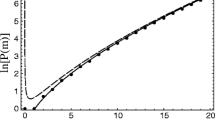Abstract
Within an exact canonical-ensemble treatment, we investigate the thermodynamics for a finite number of ideal bosons confined in a three-dimensional quartic trap. We calculate several physical quantities including the specific heat C N , chemical potential μ, condensate fraction 〈n 0〉/N, root-mean-square fluctuations δn 0 of the condensate population, and transition temperature T c . We discuss the particle-number dependence of T c through proposing three T c definitions, which are compared with ones derived in the grand canonical ensemble.




Similar content being viewed by others
References
W. Ketterle, D.S. Durfee, D.M. Stamper-Kurn, Making, probing and understanding Bose-Einstein condensates, in Bose-Einstein Condensation in Atomic Gases: Proceedings of the International School of Physics “Enrico Fermi”, Course CXL, ed. by M. Inguscio, S. Stringari, C.E. Wiemann (IOS Press, Amsterdam, 1999), pp. 67–176
M.H. Anderson, J.R. Ensher, M.R. Matthews, C.E. Wieman, E.A. Cornell, Science 269, 198 (1995)
C.C. Bradley, C.A. Sackett, J.J. Tollett, R.G. Hulet, Phys. Rev. Lett. 75, 1687 (1995)
D.M. Stamper-Kurn, M.R. Andrews, A.P. Chikkatur, S. Inouye, H.J. Miesner, J. Stenger, W. Ketterle, Phys. Rev. Lett. 80, 2027 (1998)
J.H. Wang, Y.L. Ma, J. Phys. B, At. Mol. Opt. Phys. 42, 245301 (2009)
G.Z. Su, J.C. Chen, Eur. J. Phys. 31, 143 (2010)
J.H. Wang, Y.L. Ma, Phys. Rev. A 79, 033604 (2009)
J.H. Wang, H.Y. Tang, Y.L. Ma, Ann. Phys. 326, 634 (2011)
J.H. Wang, J.Z. He, Y.L. Ma, Phys. Rev. E 83, 051132 (2011)
J.H. Wang, Y.L. Ma, J.Z. He, J. Low Temp. Phys. 162, 23 (2011)
J.H. Wang, J.Z. He, Eur. Phys. J. D 64, 73 (2011)
J.H. Wang, J.Z. He, J. Low Temp. Phys. 166, 80 (2012)
K.E. Dorfman, M. Kim, A.A. Svidzinsky, Phys. Rev. A 83, 033609 (2011)
K. Glaum, H. Kleinert, A. Pelster, Phys. Rev. A 76, 063604 (2007)
P. Navez, D. Bitouk, M. Gajda, Z. Idziaszek, K. Rzazewski, Phys. Rev. Lett. 79, 1789 (1997)
M. Wilkens, C. Weiss, J. Mod. Opt. 44, 1801 (1997)
C. Weiss, M. Wilkens, Opt. Express 1, 272 (1997)
P. Borrmann, J. Harting, O. Mülken, E.R. Hilf, Phys. Rev. A 60, 1519 (1999)
D.H.E. Gross, E.V. Votyakov, Eur. Phys. J. B 15, 115 (2000)
D.H.E. Gross, Nucl. Phys. A 681, 366 (2001)
V. Bretin, S. Stock, Y. Seurin, J. Dalibard, Phys. Rev. Lett. 92, 050403 (2004)
S. Stock, V. Bretin, F. Chevy, J. Dalibard, Europhys. Lett. 65, 594 (2004)
M. Cozzini, B. Jackson, S. Stringari, Phys. Rev. A 73, 013603 (2006)
E.Ö. Karabulut, M. Koyuncu, M. Tomak, Physica A 389, 1371 (2010)
S. Gautam, D. Angom, Eur. Phys. J. D 46, 151 (2008)
A.L. Fetter, B. Jackson, S. Stringari, Phys. Rev. A 71, 013605 (2005)
A.L. Fetter, Phys. Rev. A 64, 063608 (2001)
O. Gygi, H.G. Katzgraber, M. Troyer, S. Wessel, G.G. Batrouni, Phys. Rev. A 73, 063606 (2006)
L. Wen, Y.L. Ma, Int. J. Mod. Phys. B 22, 5003 (2008)
G.K. Chaudhary, A.K. Chattopadhyay, R. Ramakumar, Int. J. Mod. Phys. B 25, 3927 (2011)
P.M. Mathews, M. Seetharaman, S. Raghavan, J. Phys. A 15, 103 (1982)
R. Napolitano, J. De Luca, V.S. Bagnato, G.C. Marques, Phys. Rev. A 55, 3954 (1997)
G.-X. Hu, X.-X. Dai, J.-X. Dai, W.E. Evenson, J. Low Temp. Phys. 133, 239 (2003)
V.V. Kocharovsky, Vl.V. Kocharovsky, M.O. Scully, Phys. Rev. A 61, 053606 (2000)
S. Grossmann, M. Holthaus, Phys. Lett. A 208, 188 (1995)
V. Bagnato, D.E. Pritchard, D. Kleppner, Phys. Rev. A 35, 4354 (1987)
Acknowledgements
This work was supported by the National Natural Science Foundation of China under Grants No. 11147200 and 11065008, and the Foundation of Jiangxi Educational Committee under Grant No. GJJ12136.
Author information
Authors and Affiliations
Corresponding author
Appendix: Thermodynamics of an IBG in the Thermodynamic Limit
Appendix: Thermodynamics of an IBG in the Thermodynamic Limit
For an IBG in a quartic potential, one has the density of states [25]

The total number N of the particles as a function of density of states is given by

which, after integration, becomes

where N 0 is the particle number of the ground state, z=e μ/kT a fugacity, and \(g_{n}(z) =\sum_{l=1}^{\infty}\frac{z^{l}}{l^{n}} \) denote the Bose-Einstein functions. The mean energy U of the N-particle system is

where the energy of the ground state ϵ 0=0 has been used. The specific heat capacity can be determined by differentiation with respect to temperature, namely, \(C_{N}=\frac{\partial U}{\partial T}\), which leads to the specific heat above the critical temperature \(T_{c}^{0}\)


and the specific heat below \(T_{c}^{0}\)

When \(T>T_{c}^{0}\), we obtain by using the condition \(\frac{\partial N}{\partial T}=0\)

It is not verify to find that

Clearly, in the thermodynamic limit the specific heat becomes discontinuous at the critical temperature \(T_{c}^{0}\) and its maximum is equal to 5.0805. The magnitude of the jump \(\frac{\Delta C_{N}}{N k}=\frac{9}{4} \frac{\varGamma(13/4)}{\varGamma(9/4)} \frac{\zeta(\frac{9}{4})}{ \zeta(\frac{5}{4})}\simeq1.6087\) is quite significant. It indicates that the specific heat of quartically trapped, ideal bosons at the onset of condensation displays some resemblance to the specific heat of liquid 4He in the vicinity of the λ-point. As in the case of harmonic trap, the reason for the emergence of the λ-like phase transition for the quartic trap is attributed to the trapping potential instead of the interactions between atoms in the case of 4He.
Rights and permissions
About this article
Cite this article
Wang, J., Zhuang, B. & He, J. Thermodynamics of an Ideal Bose Gas with a Finite Number of Particles Confined in a Three-Dimensional Quartic Trap. J Low Temp Phys 170, 99–107 (2013). https://doi.org/10.1007/s10909-012-0669-5
Received:
Accepted:
Published:
Issue Date:
DOI: https://doi.org/10.1007/s10909-012-0669-5



